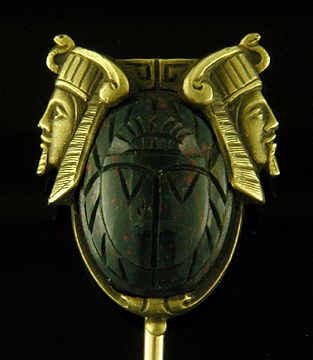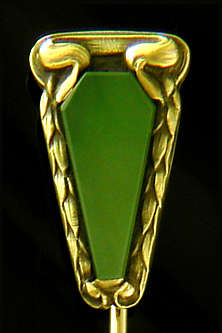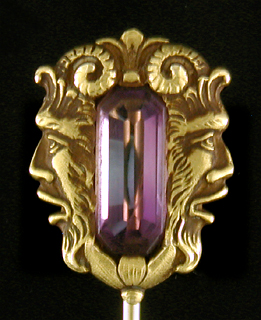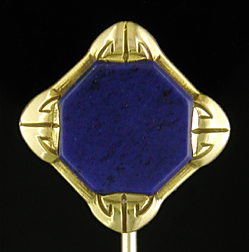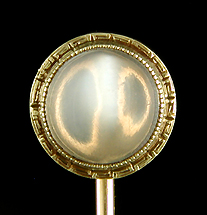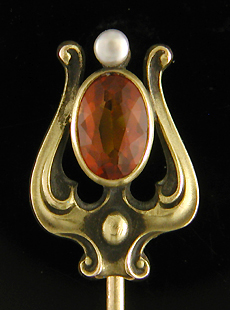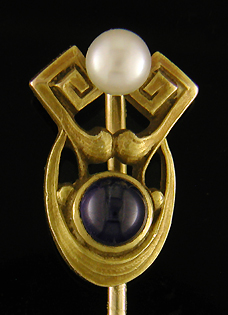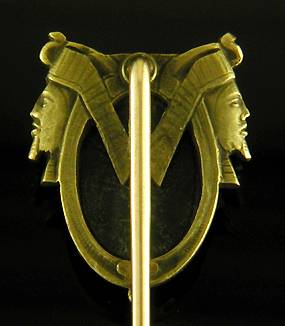
The Extraordinary Stickpins of
|
|
Hans Brassler was a wonderfully imaginative artist,
goldsmith and jewelry designer who created fine jewelry and
beautiful objects during the first half of the 20th
century. He was born in 1882 in Germany into a family of
jewelers and precious metal artists whose members several
centuries earlier were engaged in engraving decorative designs
on the arms and armor of lords and knights. Brassler
inherited his ancestors' talents for design and craftsmanship. In the late 1800s Brassler was admitted into the Academie
Julian in Paris where he pursued his artistic studies with an
emphasis on jewelry design. Family history relates that
the exemplar he submitted while seeking admission was a
painting of a butterfly. While in Paris Brassler is reported to have won a medal at
the 1900 Exposition Universelle. About this time
he was approached by a representative of Tiffany & Co and
offered a design position in New York. He accepted and,
despite his father's misgivings, emigrated to the United
States in 1902. While working at Tiffany & Co., he
found success designing silverware and jewelry. During
this period he also created cover art and jewelry
illustrations for the Jeweler's Circular and possibly other
trade publications. By 1909 he was ready to strike out on his own and founded
with partners The Brassler Company in Newark, New
Jersey. During the next half-dozen years where he served
the firm as a vice president and artistic director. The extraordinary jewels he created during this period drew upon the diverse design styles of the early 20th century - Victorian, Art Nouveau, Arts & Crafts, Edwardian and Art Deco - as well as borrowing motifs and themes from ancient and distant cultures. But the uniqueness and originality of Brassler's jewels is primarily attributable to his own unique imagination. The following is a brief survey of some of the wonderful stickpins he created. Brassler found inspiration in a variety of sources including classical mythology. This sculptural stickpin features addorsed profiles of Bacchus, the God of Wine, framing a rich amethyst. Among the ancient Greeks and Romans it was believed that amethyst protected an passionate imbiber from over intoxication, so this jewel would have been perfect for both a Bacchanalian revel and a less frenzied wine tasting. The British Arts & Crafts movement with its interest in the art and artifacts of the Middle Ages was one of the design influences of the early 20th century. This Brassler stickpin with a cruciform top and eight-side lapis lazuli reflects appears to reflect this interest. During the Middle Ages the rich blue color of lapis lazuli was prized by painters and used to color the robes of the Virgin Mary. The gemstone's association with divine and sacred symbols in earlier ages piqued the interest of late Victorians and resonated with the spiritual interests of the late 19th and early 20th centuries. Brassler worked with a variety of gemstones. His creations were colored with the rich hues of amethysts, heliotropes, citrines and sapphires. Other favored gemstones included black opal, moonstones and small white pearls. Small diamonds were occasionally set as sparkling accents. Brassler was most concerned with how the beauty and color of a gemstone complemented the design of a jewel, not necessarily its scarcity or value. A luminous moonstone is set in a golden Greek key border. In this Arts & Crafts, or is it Classical Revival, design the goldwork gives the jewel a mysterious, archaic feel. You can almost imagine this jewel being excavated from the treasury at Troy or a Mycenaean royal tomb. Brassler played with and often challenged the prevailing design themes of the early 20th century. His vision often led him to wed elements from disparate styles to create jewels of striking originality. This is no more evident than in the jewels he created in the Art Nouveau fashion. This striking citrine and pearl stickpin weds the flowing curves of Art Nouveau design with a lyre shape recalling the classical themes and symmetry favored in ancient jewelry.
In this Hans Brassler stickpin the boldness of a rich blue cabochon sapphire and outsized white pearl (possibly a replacement) anticipates later Art Deco designs. The Greek key motif cradling the pearl reflects the artist's fondness for classical elements, while the fantastic shape and flowing curves of the setting suggests the fantasy of Art Nouveau. This stickpin beautifully exemplifies Brassler's ability to imaginatively wed design elements from eclectic influences to create extraordinary jewels that are uniquely his own. Brassler took equal care in the design and the crafting of his jewels. No detail was small enough to be overlooked or obscure enough to be ignored. This commitment to excellence in craftsmanship can be seen on the reverse of Brassler's stickpins. Pictured above is the back of the Egyptian Revival stickpin illustrated at the beginning of this article. Note the repetition of the details of the Pharaohs' profiles on the usually unseen back and the continuation of the lappets of the Pharaohs' headdresses to support the back of the bloodstone. As note before, no detail was too small not to be carefully considered and designed. The maker's mark of The
Brassler Company - "14 B" in a double oval - is most often
found stamped on the back or upper pin stem of his stickpins.
Hans Brassler remained affiliated with The Brassler Company
until 1916. His involvement with the firm after that
date is unclear. In 1933 the remaining assets of The
Brassler Company were acquired by the jewelry maker Jones
& Woodland, who in turn were later acquired by Krementz
& Co.
|
|
Antique Stickpin Gallery and Antique Brooch Gallery. |
| |
||
| Antique Jewelry Galleries Antique Stickpin Gallery If you have any questions, suggestions or comments, I can be reached at .
Or, if you prefer snail mail, my postal address is: |
||
|
|
